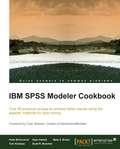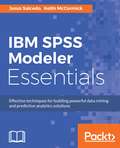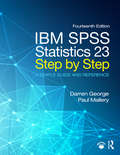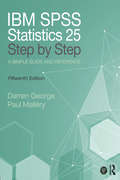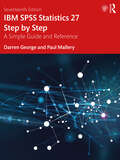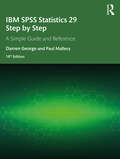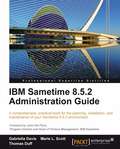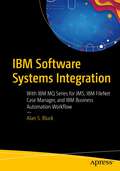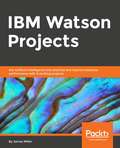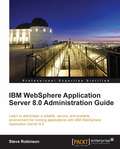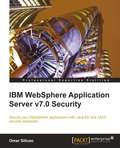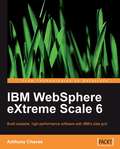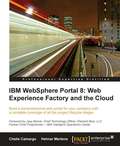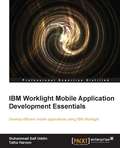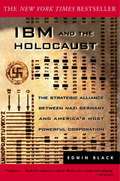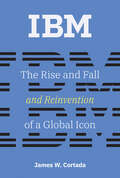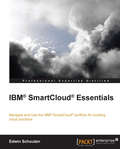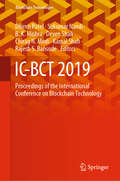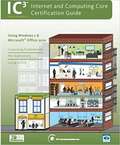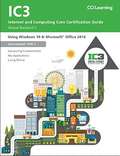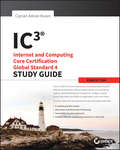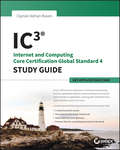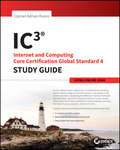- Table View
- List View
IBM SPSS Modeler Cookbook
by Scott R. Mutchler Keith Mccormick Meta S. Brown Dean Abbott Tom KhabazaThis is a practical cookbook with intermediate-advanced recipes for SPSS Modeler data analysts. It is loaded with step-by-step examples explaining the process followed by the experts.If you have had some hands-on experience with IBM SPSS Modeler and now want to go deeper and take more control over your data mining process, this is the guide for you. It is ideal for practitioners who want to break into advanced analytics.
IBM SPSS Modeler Essentials: Effective techniques for building powerful data mining and predictive analytics solutions
by Keith McCormick Jose Jesus Salcedo Bowen WeiKey Features Get up–and-running with IBM SPSS Modeler without going into too much depth. Identify interesting relationships within your data and build effective data mining and predictive analytics solutions A quick, easy–to-follow guide to give you a fundamental understanding of SPSS Modeler, written by the best in the business Book Description IBM SPSS Modeler allows users to quickly and efficiently use predictive analytics and gain insights from your data. With almost 25 years of history, Modeler is the most established and comprehensive Data Mining workbench available. Since it is popular in corporate settings, widely available in university settings, and highly compatible with all the latest technologies, it is the perfect way to start your Data Science and Machine Learning journey. This book takes a detailed, step-by-step approach to introducing data mining using the de facto standard process, CRISP-DM, and Modeler’s easy to learn “visual programming” style. You will learn how to read data into Modeler, assess data quality, prepare your data for modeling, find interesting patterns and relationships within your data, and export your predictions. Using a single case study throughout, this intentionally short and focused book sticks to the essentials. The authors have drawn upon their decades of teaching thousands of new users, to choose those aspects of Modeler that you should learn first, so that you get off to a good start using proven best practices. This book provides an overview of various popular data modeling techniques and presents a detailed case study of how to use CHAID, a decision tree model. Assessing a model’s performance is as important as building it; this book will also show you how to do that. Finally, you will see how you can score new data and export your predictions. By the end of this book, you will have a firm understanding of the basics of data mining and how to effectively use Modeler to build predictive models. What you will learn Understand the basics of data mining and familiarize yourself with Modeler’s visual programming interface Import data into Modeler and learn how to properly declare metadata Obtain summary statistics and audit the quality of your data Prepare data for modeling by selecting and sorting cases, identifying and removing duplicates, combining data files, and modifying and creating fields Assess simple relationships using various statistical and graphing techniques Get an overview of the different types of models available in Modeler Build a decision tree model and assess its results Score new data and export predictions
IBM SPSS Statistics 23 Step by Step: A Simple Guide and Reference (14th Edition)
by Darren George Paul MalleryIBM SPSS Statistics 23 Step by Step: A Simple Guide and Reference, 14e, takes a straightforward, step-by-step approach that makes SPSS software clear to beginners and experienced researchers alike. Extensive use of vivid, four-color screen shots, clear writing, and step-by-step boxes guide readers through the program. Exercises at the end of each chapter support students by providing additional opportunities to practice using SPSS. All datasets used in the book are available for download at: https://www.routledge.com/products/ 9780134320250
IBM SPSS Statistics 25 Step by Step: A Simple Guide and Reference
by Darren George Paul MalleryIBM SPSS Statistics 25 Step by Step: A Simple Guide and Reference, fifteenth edition, takes a straightforward, step-by-step approach that makes SPSS software clear to beginners and experienced researchers alike. Extensive use of four-color screen shots, clear writing, and step-by-step boxes guide readers through the program. Exercises at the end of each chapter support students by providing additional opportunities to practice using SPSS. This book covers both the basics of descriptive statistical analysis using SPSS through to more advanced topics such as multiple regression, multidimensional scaling and MANOVA, including instructions for Windows and Mac. This makes it ideal for both undergraduate statistics courses and for postgraduates looking to further develop their statistics and SPSS knowledge. New to this edition: Updated throughout to SPSS 25 Updated / restructured material on: Chart Builder; Univariate ANOVA; moderation on two- and three-way ANOVA; and Factor Analytic Techniques (formerly Factor Analysis structure) New material on computing z and T scores, and on computing z scores within descriptive statistics Clearer in-chapter links between the type of data and type of research question that the procedure can answer Updated / additional datasets, exercises, and expanded Companion Website material, including Powerpoint slides for instructors
IBM SPSS Statistics 26 Step by Step: A Simple Guide and Reference
by Darren George Paul MalleryIBM SPSS Statistics 26 Step by Step: A Simple Guide and Reference, sixteenth edition, takes a straightforward, step-by-step approach that makes SPSS software clear to beginners and experienced researchers alike. Extensive use of four-color screen shots, clear writing, and step-by-step boxes guide readers through the program. Output for each procedure is explained and illustrated, and every output term is defined. Exercises at the end of each chapter support students by providing additional opportunities to practice using SPSS. This book covers the basics of statistical analysis and addresses more advanced topics such as multi-dimensional scaling, factor analysis, discriminant analysis, measures of internal consistency, MANOVA (between- and within-subjects), cluster analysis, Log-linear models, logistic regression and a chapter describing residuals. Back matter includes a description of data files used in exercises, an exhaustive glossary, suggestions for further reading and a comprehensive index. IMB SPSS Statistics 26 Step by Step is distributed in 85 countries, has been an academic best seller through most of the earlier editions, and has proved invaluable aid to thousands of researchers and students. New to this edition: Screenshots, explanations, and step-by-step boxes have been fully updated to reflect SPSS 26 How to handle missing data has been revised and expanded and now includes a detailed explanation of how to create regression equations to replace missing data More explicit coverage of how to report APA style statistics; this primarily shows up in the Output sections of Chapters 6 through 16, though changes have been made throughout the text.
IBM SPSS Statistics 27 Step by Step: A Simple Guide and Reference
by Darren George Paul MalleryIBM SPSS Statistics 27 Step by Step: A Simple Guide and Reference, seventeenth edition, takes a straightforward, step-by-step approach that makes SPSS software clear to beginners and experienced researchers alike. Extensive use of four-color screen shots, clear writing, and step-by-step boxes guide readers through the program. Output for each procedure is explained and illustrated, and every output term is defined. Exercises at the end of each chapter support students by providing additional opportunities to practice using SPSS. This book covers the basics of statistical analysis and addresses more advanced topics such as multidimensional scaling, factor analysis, discriminant analysis, measures of internal consistency, MANOVA (between- and within-subjects), cluster analysis, Log-linear models, logistic regression, and a chapter describing residuals. The end sections include a description of data files used in exercises, an exhaustive glossary, suggestions for further reading, and a comprehensive index. IBM SPSS Statistics 27 Step by Step is distributed in 85 countries, has been an academic best seller through most of the earlier editions, and has proved an invaluable aid to thousands of researchers and students. New to this edition: Screenshots, explanations, and step-by-step boxes have been fully updated to reflect SPSS 27 A new chapter on a priori power analysis helps researchers determine the sample size needed for their research before starting data collection.
IBM SPSS Statistics 29 Step by Step: A Simple Guide and Reference
by Darren George Paul MalleryIBM SPSS Statistics 29 Step by Step: A Simple Guide and Reference, eighteenth edition, takes a straightforward, step-by-step approach that makes SPSS software clear to beginners and experienced researchers alike.Extensive use of four-color screen shots, clear writing, and step-by-step boxes guide readers through the program. Output for each procedure is explained and illustrated, and every output term is defined. Exercises at the end of each chapter support students by providing additional opportunities to practice using SPSS. This book covers the basics of statistical analysis and addresses more advanced topics such as multidimensional scaling, factor analysis, discriminant analysis, measures of internal consistency, MANOVA (between- and within-subjects), cluster analysis, Log-linear models, logistic regression, and a chapter describing residuals. New to this edition is a new chapter on meta-analysis that describes new SPSS procedures for analyzing effect sizes across studies, and the content has been thoroughly updated in line with the latest version of the SPSS software, SPSS 29. The end sections include a description of data files used in exercises, an exhaustive glossary, suggestions for further reading, and a comprehensive index.Accompanied by updated online instructor’s materials and website data files, this is an essential resource for instructors and students needing a guide to using SPSS in their work, across the social sciences, behavioural sciences, education, and beyond.
IBM Sametime 8.5.2 Administration Guide
by Marie L. Scott Gabriella DavisThe IBM Lotus Sametime 8.5.2 Administration Guide uses a practical, no-nonsense approach to give you the essential information you need. Using realistic scenarios, you learn how to configure and maintain your environment to meet your needs and take advantage of the flexibility offered in Sametime 8.5.2. If you are responsible for installing and administering Sametime 8.5.2, then this book is for you. If you're completely new to Sametime administration, this book will serve as your roadmap. If you're making the jump from a prior version of Sametime, then you'll see how Sametime 8.5.2 differs and how you work with the new configuration. Even if you already have Sametime 8.5.2 up and running, this guide will answer those questions you may still have of why and how the various server components work.
IBM Software Systems Integration: With IBM MQ Series for JMS, IBM FileNet Case Manager, and IBM Business Automation Workflow
by Alan S. BluckExamine the working details for real-world Java programs used for system integration with IBM Software, applying various API libraries (as used by Banking and Insurance companies). This book includes the step-by-step procedure to use the IBM FileNet Case Manager 5.3.3 Case Builder solution and the similar IBM System, IBM Business Automation Workflow to create an Audit System. You'll learn how to implement the workflow with a client Java Message Service (JMS) java method developed with Workflow Custom Operations System Step components. Using IBM Cognos Analytics Version 11.2, you'll be able to create new views for IBM Case Manager Analytics for custom time dimensions. The book also explains the SQL code and procedures required to create example Online Analytical Processing (OLAP) cubes with multi-level time dimensions for IBM Case Manager analytics.IBM Software Systems Integration features the most up to date systems software procedures using tested API calls.What You Will Learn Review techniques for generating custom IBM JMS codeCreate a new custom view for a multi-level time dimensionSee how a java program can provide the IBM FileNet document management API calls for content store folder and document replicationConfigure Java components for content engine events Who This Book Is ForIT consultants, Systems and Solution Architects.
IBM Watson Projects: Eight exciting projects that put artificial intelligence into practice for optimal business performance
by James MillerIncorporate intelligence to your data-driven business insights and high accuracy business solutionsKey FeaturesExplore IBM Watson capabilities such as Natural Language Processing (NLP) and machine learningBuild projects to adopt IBM Watson across retail, banking, and healthcareLearn forecasting, anomaly detection, and pattern recognition with ML techniquesBook DescriptionIBM Watson provides fast, intelligent insight in ways that the human brain simply can't match. Through eight varied projects, this book will help you explore the computing and analytical capabilities of IBM Watson.The book begins by refreshing your knowledge of IBM Watson's basic data preparation capabilities, such as adding and exploring data to prepare it for being applied to models. The projects covered in this book can be developed for different industries, including banking, healthcare, media, and security. These projects will enable you to develop an AI mindset and guide you in developing smart data-driven projects, including automating supply chains, analyzing sentiment in social media datasets, and developing personalized recommendations.By the end of this book, you'll have learned how to develop solutions for process automation, and you'll be able to make better data-driven decisions to deliver an excellent customer experience.What you will learnBuild a smart dialog system with cognitive assistance solutionsDesign a text categorization model and perform sentiment analysis on social media datasetsDevelop a pattern recognition application and identify data irregularities smartlyAnalyze trip logs from a driving services company to determine profitProvide insights into an organization's supply chain data and processesCreate personalized recommendations for retail chains and outletsTest forecasting effectiveness for better sales prediction strategiesWho this book is forThis book is for data scientists, AI engineers, NLP engineers, machine learning engineers, and data analysts who wish to build next-generation analytics applications. Basic familiarity with cognitive computing and sound knowledge of any programming language is all you need to understand the projects covered in this book.
IBM WebSphere Application Server 8.0 Administration Guide
by Steve RobinsonIBM WebSphere Application Server 8.0 Administration Guide is a highly practical, example-driven tutorial. You will be introduced to WebSphere Application Server 8.0, and guided through configuration, deployment, and tuning for optimum performance. If you are an administrator who wants to get up and running with IBM WebSphere Application Server 8.0, then this book is not to be missed. Experience with WebSphere and Java would be an advantage, but is not essential.
IBM WebSphere Application Server v7.0 Security
by Omar SiliceoWith this book you will explore WebSphere Application Server security concepts, which you can expand upon while working on mini-projects. With the author's style of writing you will gain the knowledge and confidence needed to implement WebSphere Application Servers securely. Right from the basics of securing your WebSphere Application Server to advanced security features, the author utilizes exercises, screenshots, and clear instructions. If you are a system administrator or an IT professional who wants to learn about the security side of the IBM WebSphere Application Server v7.0, this book will walk you through the key aspects of security and show you how to implement them. You do not need any previous experience in WebSphere Application Server, but some understanding of Java EE technologies will be helpful. In addition, Java EE application developers and architects who want to understand how the security of a WebSphere environment affects Java EE enterprise applications will find this book useful.
IBM WebSphere eXtreme Scale 6
by Anthony ChavesThis book is a real-world practical tutorial with lots of examples. The data grid concepts are clearly explained and code samples are provided. The concepts are applicable to all IMDGs, and the examples represent the eXtreme Scale approach to the problem. This book is aimed at intermediate-level JavaEE Developers who want to build applications that handle larger data sets with massive scalability requirements. No previous experience of WebSphere eXtreme Scale is required.
IBM Websphere Portal 8: Web Experience Factory and the Cloud
by Chelis Camargo Helmar MartensThis book is written in simple, easy to understand format with lots of screenshots and step-by-step explanations. If you are an IBM WebSphere Portal developer, looking to develop and enhance enterprise portals by understanding the complete portal project lifecycle, then this is the best guide for you. This book assumes that you have a fundamental knowledge of working in the WebSphere Portal environment.
IBM Worklight Mobile Application Development Essentials
by Talha Haroon Muhammad Saif UddinThis book will guide you through the process of building an application and customizing it with the help of lucid instructions on development, configuration, and administration with a practical, step-by-step approach. If you are a developer who wants to create mobile applications quickly, this is the book for you. Some basic knowledge about of web technologies and client -side languages such as JavaScript, CSS and HTML will serve you well.
IBM and the Holocaust: The Strategic Alliance Between Nazi Germany and America's Most Powerful Corporation
by Edwin BlackNow in paperback, this is the shocking, impeccably researched, and incredibly detailed story of IBM's strategic alliance with Nazi Germany. Edwin Black's chilling investigation into corporate complicity in the atrocities raises startling questions and throws IBM's wartime ethics into serious doubt. Copyright © Libri GmbH. All rights reserved.
IBM: The Rise and Fall and Reinvention of a Global Icon (History of Computing #1775)
by James W. CortadaA history of one of the most influential American companies of the last century.For decades, IBM shaped the way the world did business. IBM products were in every large organization, and IBM corporate culture established a management style that was imitated by companies around the globe. It was “Big Blue, ” an icon. And yet over the years, IBM has gone through both failure and success, surviving flatlining revenue and forced reinvention. The company almost went out of business in the early 1990s, then came back strong with new business strategies and an emphasis on artificial intelligence. In this authoritative, monumental history, James Cortada tells the story of one of the most influential American companies of the last century.Cortada, a historian who worked at IBM for many years, describes IBM's technology breakthroughs, including the development of the punch card (used for automatic tabulation in the 1890 census), the calculation and printing of the first Social Security checks in the 1930s, the introduction of the PC to a mass audience in the 1980s, and the company's shift in focus from hardware to software. He discusses IBM's business culture and its orientation toward employees and customers; its global expansion; regulatory and legal issues, including antitrust litigation; and the track records of its CEOs. The secret to IBM's unequalled longevity in the information technology market, Cortada shows, is its capacity to adapt to changing circumstances and technologies.
IBM® SmartCloud® Essentials
by Edwin SchoutenA practical, user-friendly guide that provides an introduction to cloud computing using IBM SmartCloud, along with a thorough understanding of resource management in a cloud environment.This book is great for anyone who wants to get a grasp of what cloud computing is and what IBM SmartCloud has to offer. If you are an IT specialist, IT architect, system administrator, or a developer who wants to thoroughly understand the cloud computing resource model, this book is ideal for you. No prior knowledge of cloud computing is expected.
IC-BCT 2019: Proceedings of the International Conference on Blockchain Technology (Blockchain Technologies)
by Sukumar Nandi Chirag N. Modi Kamal Shah Dhiren Patel B. K. Mishra Deven Shah Rajesh S. BansodeThis book presents articles from the International Conference on Blockchain Technology (IC-BCT) 2019, held in Mumbai, India, and highlights recent advances in the field. It brings together researchers and industry practitioners to show case their ideas linked to business case studies, and provides an opportunity for engineers, researchers, startups and professionals in the field of Blockchain technology to further collaboration.
IC3 Global Standard 4: Using Windows 7 & Microsoft Office 2010
by CCI Learning Solutions Inc.Welcome to the Internet and Computing Core Certification Guide Solid technical content, powerful graphics and hands-on exercises in this textbook will provide you with the fundamental knowledge and skills for working with computers. This textbook will also prepare you for IC3 certification. What is IC3? IC3 - the Internet and Computing Core Certification - tests basic computer skills and understanding of the Internet to promote success in school, work and life. Developed by Certiport, the IC3 program enjoys worldwide recognition as the global standard for digital literacy.
IC3 Global Standard 5 Internet and Computing Core Certification Guide
by Cci LearningNow you can effectively prepare for success with the IC3 (Internet and Computing Core Certification program) with IC3 INTERNET AND COMPUTING CORE CERTIFICATION GUIDE USING MICROSOFT WINDOWS 7 AND MICROSOFT OFFICE 2013. The IC3 global training and certification program proves you are equipped with computer skills to excel in a digital world. It shows you are capable of using of computer technology ranging from basic hardware and software to operating systems, applications, and the Internet. These skills position you to advance your career through additional computer certifications, such as CompTIA's A+ and similar exams. Today, more than ever, an understanding of computers and Internet skills are prerequisites for higher education and employment. This book provides the knowledge and skills that a functional user of computer hardware, software, networks, and the Internet needs with comprehensive instruction, lesson objectives, hands-on lab exercises, and course-specific terms.
IC3: Internet and Computing Core Certification Computing Fundamentals Study Guide
by Ciprian Adrian RusenTest how well you know your way around a computer for the IC3 exam IC3: Internet and Computing Core Certification Computing Fundamentals Study Guide is your ideal study guide to focus on the Computing Fundamentals exam module in preparation for the IC3 exam. This book covers hardware, software, peripherals, operating systems, and basic troubleshooting, presented in a clear, concise style. Hands-on examples and self-paced exercises show you how to perform critical tasks needed to pass the exam, and the companion website offers a diverse set of study tools including the Sybex test engine, a preassessment test, practice questions, and videos. Readers also gain access to electronic flashcards, and the chapter files needed to complete the exercises in the book. This guide focuses on the Computing Fundamentals module helping you test your skills and solidify your understanding in preparation for the exam. Review the various hardware components essential to the computer Understand which peripherals are crucial, and which are nice to have Brush up on basic troubleshooting for common minor issues Master your operating system and fundamental software When you are serious about certification, IC3 provides the practice that inspires self-confidence.
IC3: Internet and Computing Core Certification Global Standard 4 Study Guide
by Ciprian Adrian RusenHands-on IC3 prep, with expert instruction and loads of tools IC3: Internet and Computing Core Certification Global Standard 4 Study Guide is the ideal all-in-one resource for those preparing to take the exam for the internationally-recognized IT computing fundamentals credential. Designed to help candidates pinpoint weak areas while there's still time to brush up, this book provides one hundred percent coverage of the exam objectives for all three modules of the IC3-GS4 exam. Readers will find clear, concise information, hands-on examples, and self-paced exercises that demonstrate how to perform critical tasks. This useful guide includes access to a robust set of learning tools, including chapter review questions, a practice test environment, electronic flashcards, and author videos that explain complex topics. The certification consists of three separate exams: Computing Fundamentals, Key Applications, and Living Online. Candidates are given fifty minutes to answer forty-five questions, so rapid recall and deep understanding are critical to success. IC3: Internet and Computing Core Certification Global Standard 4 Study Guide provides expert instruction on everything candidates need to know, including hardware, software, networking, and more. Review operating system basics and common application features Understand troubleshooting and safe computing Learn basic word processing, spreadsheet, presentation, and database activities Study networking concepts, digital communication, and research fluency The exam includes both multiple choice and performance-based questions, and this guide provides plenty of both so candidates can get comfortable with both material and format. More than just a memorization tool, this book helps exam candidates understand the material on a fundamental level, giving them a greater chance of success than just going it alone. For the IC3 candidate who's serious about certification, IC3: Internet and Computing Core Certification Global Standard 4 Study Guide is the complete, hands-on exam prep guide.
IC3: Internet and Computing Core Certification Key Applications Global Standard 4 Study Guide
by Ciprian Adrian RusenMaster word processing, spreadsheets, and presentations ahead of the IC3 exam IC3: Internet and Computing Core Certification Key Applications Study Guide is your ideal study guide when you want to focus on the Key Applications exam module in preparation for the IC3. This book covers common features and functions, word processing, spreadsheets, and presentations, all presented in a clear, concise style. Hands-on examples and self-paced exercises show you how to perform critical tasks needed to pass the exam, and the companion website offers a diverse set of study tools including the Sybex test engine, a preassessment test, hundreds of practice questions, videos, and access to over one hundred electronic flashcards. Test your skills and solidify your understanding of Key Applications for the IC3. Master the functions common to all programs, and the most common features Review the basics of word processing, with formatting and automation Understand spreadsheets, and how to manipulate data with formulas Brush up on the creation and formatting of simple presentations When you are serious about certification, IC3 provides the practice that inspires self-confidence.
IC3: Internet and Computing Core Certification Living Online Study Guide
by Ciprian Adrian RusenUse the Internet safely and ethically in preparation for the IC3 exam IC3: Internet and Computing Core Certification Living Online Study Guide is your ideal study guide to focus on the Living Online exam module in preparation for the IC3 exam. This book covers working in a networked environment, using the Internet, electronic collaboration, and the safety issues surrounding online communication, presented in a clear, concise style. Hands-on examples and self-paced exercises show readers how to perform critical tasks needed to pass the exam, and the companion website offers study tools including the Sybex test engine, a pre-assessment test, practice questions, and videos. You will also have access to over one hundred electronic flashcards, and the chapter files needed to complete the exercises in the book. The Internet and Computing Core Certification exam measures a candidate on key and fundamental computing skills, ensuring their ability to get the most value and impact from computer technology. This guide focuses on the Living Online module of the IC3, testing your skills and solidifying your understanding in preparation for the exam. Review the basics of electronic communication and collaboration Master internet navigation and the networked environment Understand computing and the Internet's impact on society at large Brush up on the safety, ethical, and responsibility issues of Internet use When you are serious about certification, IC3 provides the practice that inspires self-confidence.
